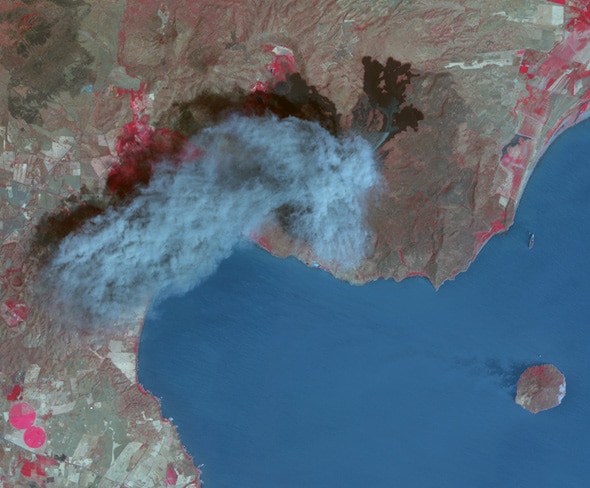Create a free profile to get unlimited access to exclusive videos, sweepstakes, and more!
An Active Volcano Eruption Caught From Space

Momotombo’s been busy.
This volcano, located off Lake Managua (also called Lago Xolotlán) in Nicaragua, has erupted a handful of times in modern history, but starting in March it started popping off hundreds of small explosions, which have thrown an ash plume into the air above it.
The image above was taken by the Terra Earth-observing satellite on March 2. It’s a combination of visible light (green and red, shown as blue and green) and infrared (shown as red). As I mentioned in an earlier post, vegetation is extremely reflective in infrared, so it looks very red in this image. The plume winds up looking bluish-gray in this combination. Old lava flows are dark brown, and newer ones are more gray-brown.
The plume is roughly 10 kilometers long, to give you some scale. Also, look off to the lower right, in the lake: There lies Isla Momotombito, another stratovolcano. This literally means Little Momotombo Island, which would be adorable if we weren’t talking about a huge pile of rocks surrounding a massive hole that leads down into the Earth’s hellish mantle.
As for Momotombo, the name is Aztec, and apparently means “Big Boiling Summit.” Fair enough.
As regular readers know, I’m fascinated by satellite imagery of volcanoes, but I think that’s a fair thing to be fascinated by. Look at that image! And of course this is terribly useful: Thousands of people live in that area, and satellite images like this one can help authorities understand the situation better, possibly helping in evacuation and rescue efforts if necessary.
That whole part of the world is lousy with volcanoes, many of which are quite active. It’s a populated area, which means they have eyes on the ground, but it’s also helpful to have eyes in the sky, too. Especially with long-term effects: Lava flows and ash plumes can be tracked, vegetation mapped to see what’s affected and where, and more.
We humans have a predilection for living near volcanoes, even when we really should know better. Still, as long as we do, keeping a watch on them from space is a very, very good idea.


























